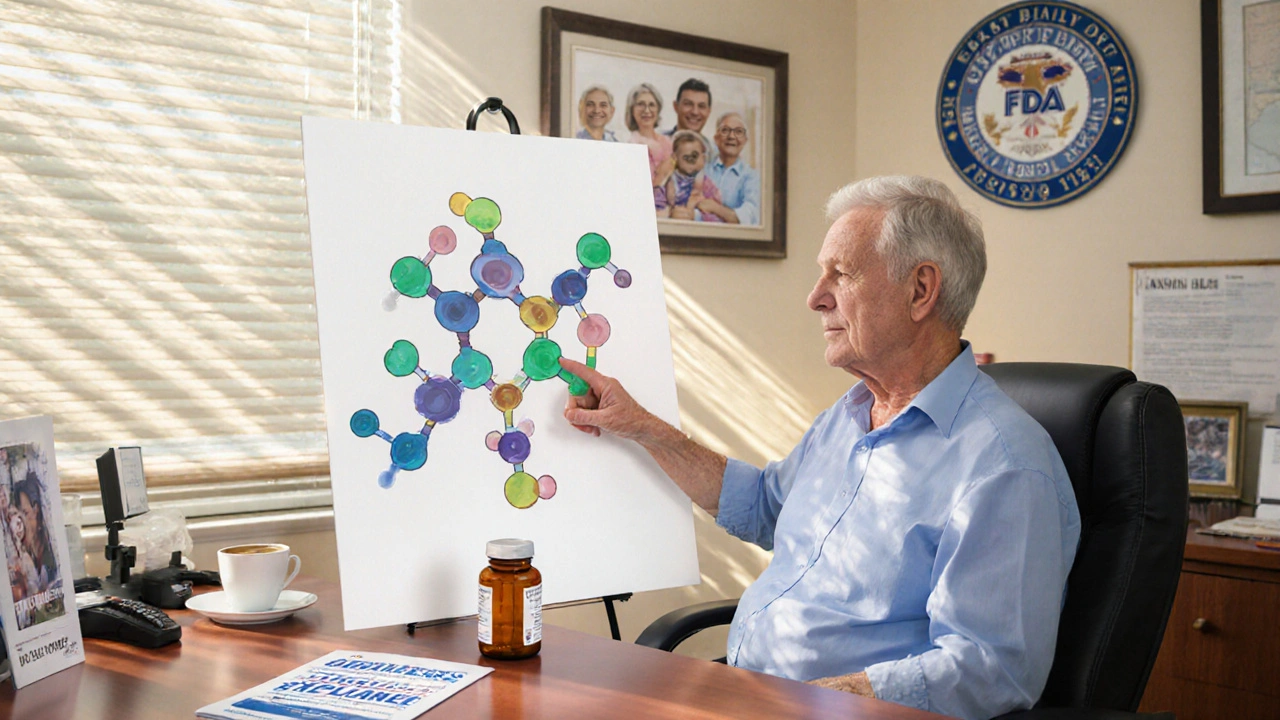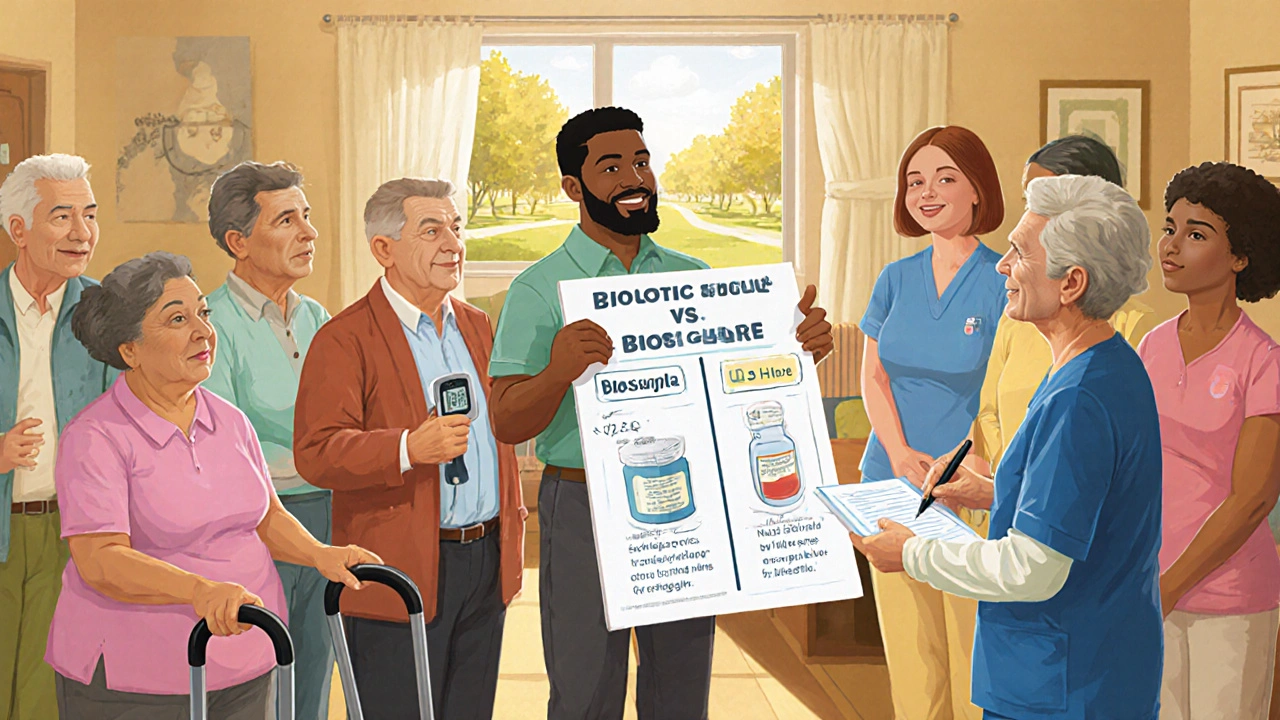What Are Biosimilars? A Simple Guide for Patients
 Nov, 17 2025
Nov, 17 2025
When your doctor talks about a new medicine to treat your arthritis, diabetes, or cancer, you might hear the word biosimilar. It sounds complicated - and maybe a little scary. But here’s the truth: biosimilars aren’t experimental. They’re not cheap knockoffs. And they’re not the same as generic pills you’ve taken before. They’re a different kind of medicine altogether - and they’re helping more people get the treatment they need at a lower cost.
What Makes a Biosimilar Different From a Regular Drug?
Most pills you take - like aspirin or metformin - are made from chemicals you can mix in a lab. These are called small-molecule drugs. Generics are exact copies of those. If you switch from brand-name Lipitor to generic atorvastatin, you’re getting the same chemical, same dose, same effect. Biosimilars are nothing like that. Biologic drugs - the ones biosimilars copy - are made from living cells. Think of them as tiny biological machines: proteins, antibodies, or enzymes grown in labs using human or animal cells. They’re huge, complex molecules with shapes that matter just as much as their chemical makeup. Even tiny changes in how they’re made - the type of cell used, the temperature during growth, the purification process - can change how they work in your body. A biosimilar isn’t an exact copy. It’s a highly similar version. The FDA requires it to match the original biologic in safety, strength, how it works, and how your body responds to it. But because living cells are involved, it can’t be identical - just as two identical twins aren’t exactly the same person.How Do We Know Biosimilars Are Safe?
You might worry: if it’s not the same, how do we know it works? The answer is science - and lots of it. Before the FDA approves a biosimilar, the manufacturer must prove it’s nearly identical to the original drug in more than 100 different ways. This includes:- Checking the molecular structure under powerful microscopes
- Testing how it binds to targets in your body
- Running animal studies to watch for side effects
- Conducting clinical trials with hundreds of patients
Biosimilars vs. Generics: What’s the Real Difference?
This is where people get confused. Let’s clear it up:| Feature | Generic Drugs | Biosimilars |
|---|---|---|
| What they copy | Small-molecule chemical drugs | Large, complex biologic drugs |
| Can they be identical? | Yes - same chemical structure | No - highly similar, but not identical |
| How they’re made | Chemical synthesis in a lab | Using living cells (like yeast or hamster cells) |
| Testing required | Basic bioequivalence studies | Extensive analytical, animal, and clinical testing |
| Examples | Generic ibuprofen, generic metformin | Zarxio (for Neupogen), Renflexis (for Remicade) |

Why Do Biosimilars Matter to Patients?
Biologic drugs are expensive. Some cost over $10,000 a month. That’s why many patients delay treatment or skip doses. Biosimilars change that. They’re typically 15% to 30% cheaper than the original biologic. In some cases, the price drop has been even bigger after multiple biosimilars enter the market. For example, when biosimilars for adalimumab (Humira) started appearing, the original drug’s price dropped by nearly 50% - even though the biosimilars themselves were priced lower. This isn’t just about saving money. It’s about access. A patient with rheumatoid arthritis who couldn’t afford Humira might now get a biosimilar and finally control their pain. A person with cancer might get a biosimilar version of trastuzumab (Herceptin) and complete their treatment without bankruptcy.What Should You Do If Your Doctor Suggests a Biosimilar?
It’s natural to feel unsure. Here’s what you need to know:- It’s not a downgrade. You’re not getting a lesser medicine. You’re getting a medicine proven to work the same way.
- It might be required by your insurance. Many insurers now require you to try a biosimilar before covering the brand-name drug.
- It has a different name. Biosimilars have the same base name as the original, but with a four-letter suffix. For example, the biosimilar for adalimumab is called adalimumab-afzb. This helps track which one you’re taking.
- You can switch safely. Studies show switching from a brand-name biologic to a biosimilar doesn’t increase side effects or reduce effectiveness.
- Ask questions. Talk to your doctor or pharmacist. Ask: “Is this a biosimilar? How does it compare to the one I’ve been taking?”
What About Interchangeable Biosimilars?
There’s a special category called “interchangeable” biosimilars. These are biosimilars that the FDA says can be swapped for the original drug without your doctor’s approval - just like a pharmacist can swap a brand-name pill for its generic. The first one approved in the U.S. was Semglee, an interchangeable version of insulin glargine (Lantus). This means if you’re prescribed Lantus, your pharmacist can give you Semglee instead - unless you or your doctor says no. More interchangeable biosimilars are expected in the next few years, especially for insulin and arthritis drugs.
What’s Next for Biosimilars?
The market is growing fast. In 2023, there were 32 biosimilars available in the U.S. - up from just one in 2015. The global market is projected to hit over $30 billion by 2028. New biosimilars are coming for major drugs like:- Bevacizumab (Avastin) - used for colon and lung cancer
- Rituximab (Rituxan) - used for lymphoma and autoimmune diseases
- Insulin glargine - used for type 1 and type 2 diabetes
Bottom Line: You’re Not Taking a Risk - You’re Gaining Access
Biosimilars aren’t a compromise. They’re a breakthrough. They bring the power of cutting-edge biologic medicine to people who couldn’t afford it before. They’re not generics. They’re not placebos. They’re not experimental. They’re science-backed, FDA-approved, and proven to work just like the original - at a lower price. If your doctor suggests one, don’t assume it’s second-rate. Ask for the facts. Talk to your pharmacist. Read the FDA’s patient guide. You might find out you’ve been given a better chance - not a cheaper one.Are biosimilars the same as generics?
No. Generics are exact chemical copies of small-molecule drugs, like aspirin or metformin. Biosimilars are highly similar versions of complex biologic drugs made from living cells. They can’t be identical, but they must work the same way and have no meaningful differences in safety or effectiveness.
Are biosimilars safe?
Yes. The FDA requires biosimilars to go through rigorous testing - including analytical studies, animal tests, and clinical trials with hundreds of patients - to prove they’re as safe and effective as the original biologic. Millions of patients in Europe and the U.S. have used them with no new safety concerns.
Can I switch from a biologic to a biosimilar?
Yes. Multiple studies show switching from a brand-name biologic to a biosimilar is safe and doesn’t reduce effectiveness or increase side effects. Your doctor may recommend it, or your insurance might require it to save costs.
Why do biosimilars have different names?
Biosimilars have the same base name as the original biologic, but with a four-letter suffix (like infliximab-dyyb). This helps doctors and pharmacists track which product you’re using, especially for reporting side effects or managing treatment.
Will my insurance cover a biosimilar?
Most insurance plans now prefer biosimilars because they’re cheaper. Some require you to try a biosimilar before covering the brand-name drug. Others automatically switch you unless you or your doctor object. Always check with your plan.
Are biosimilars available for all biologic drugs?
Not yet - but more are coming. As of 2025, biosimilars are approved for major drugs used in cancer (like trastuzumab), arthritis (like adalimumab and infliximab), diabetes (insulin), and eye disease. Many more are in development, especially for high-cost biologics with expired patents.

Conor McNamara
November 19, 2025 AT 07:42so u know what i heard? theyre not really biosimilars... its all a pharma plot to make us dependent on their stuff. they inject tracking chips in em. i read it on a forum. my cousin works at the FDA (lol) and he said they hide the real data. dont trust the names with the 4-letter suffixes. its coded. watch your bloodwork.
steffi walsh
November 20, 2025 AT 20:22OMG this is so important!! 🙌 I was so scared when my doc suggested a biosimilar for my rheumatoid arthritis, but after reading this? I switched last month and my pain is actually better!! 💪 No more $12k monthly bills!! Thank you for explaining it so clearly!!
Leilani O'Neill
November 21, 2025 AT 02:33How can anyone with half a brain trust a medicine grown in hamster cells? This is why American healthcare is a joke. In Ireland, we have standards. This isn’t medicine-it’s biotech theater. The FDA is a puppet of Big Pharma. And don’t get me started on those ‘interchangeable’ labels. Pathetic.
Riohlo (Or Rio) Marie
November 22, 2025 AT 19:51Let’s be real-biosimilars are the pharmaceutical equivalent of a knockoff Gucci bag with slightly uneven stitching. The FDA’s ‘highly similar’ is just corporate-speak for ‘close enough to not get sued.’ And yet, we’re supposed to be thrilled because it’s 30% cheaper? Please. I’d rather pay more for the original than gamble with a protein that might have been cultured in a lab that once smelled like burnt toast.
Yash Nair
November 24, 2025 AT 13:58indians have been using biosimilars for 10 years and no one died. usa still crying like babies. you think your body is special? my cousin took biosimilar for cancer and now he runs marathons. stop listening to american fearmongering. science is science. dont be weak.
Bailey Sheppard
November 25, 2025 AT 06:31I really appreciate how clear this was. I was nervous about switching from Humira to the biosimilar, but now I feel way more confident. My pharmacist even printed me a comparison sheet. It’s not about saving money-it’s about making sure people aren’t forced to choose between meds and rent. Kudos to whoever wrote this.
Girish Pai
November 26, 2025 AT 09:52From a biotech R&D perspective, the analytical comparability cascade for biosimilars is a masterpiece of regulatory science. The orthogonal assays-SEC-HPLC, CE-SDS, LC-MS, SPR binding kinetics, FcγR functional assays-collectively validate structural and functional homology at an unprecedented level. The clinical trials are powered for non-inferiority with pre-specified equivalence margins. This isn’t generics 2.0-it’s precision biologics replication. The market dynamics are just the tip of the iceberg.
Kristi Joy
November 26, 2025 AT 15:30Thank you for writing this. I’m a nurse and I’ve seen patients cry because they can’t afford their meds. One woman told me she was skipping doses to pay for her daughter’s school supplies. When we switched her to the biosimilar? She cried again-but this time because she could finally sleep through the night. This isn’t just science. It’s dignity.